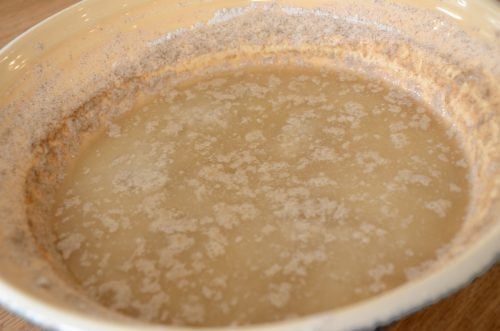This Easy 48 Hour Rye Sourdough Starter uses a very streamlined, no fuss approach.
The traditional ones involves 5 - 7 days of feeding fermenting flour and water, discarding half the mixture along the way. You can see how to to start a traditional sourdough starter but this one from Martha Stewart yields a starter within 48 hours.
How often is the Martha Stewart recipe the simplest one?? I do trust her though so here goes nothing!
The reason I turned to sourdough is because in this period of Covid 19 self isolation I have not been able to find yeast in the stores. Thanks goodness I have a few Tablespoons left in my jar but it is now taking on the preciousness of gold!
I researched all kinds of articles and recipes on sourdough starter and found 2 main approaches. The traditional 5-7 day starter does not use commercial yeast. It relies on ambient yeast from the air and the flour to start the fermentation. Bonus.
The other faster approach uses some commercial yeast, and a few other ingredients, like sugar and buttermilk to start the fermentation and feed the starter. I decided it was worth investing one teaspoon of my precious yeast to get a robust starter going. After that I just have to feed it equal parts flour and water every week or two.

Ingredients for Rye Sourdough Starter 
Just mixed 
After 48 hours Store in a clean jar
A Word About The Ingredients
- Rye flour is chosen here to give your starter a bit more flavour profile. I started the starter with rye flour but I feed it with whole wheat flour. You can use all purpose or whole wheat flour but they will have a milder flavour.
- Buttermilk - provides the culture that is going to nurture the yeast
- Sugar- feeds the yeast to support fermentation
This dough can be stored indefinitely in the fridge in an airtight container. When the starter has run out of 'fuel' and needs to be fed it will turn soupy. Do not be alarmed - just stir it thoroughly until it is smooth and fully mixed again. Proceed with discarding ½ and feeding it an equal amount of water and flour. I use ½ cup of each every week.
Check out Martha Stewart's Rye Bread Recipe. Although it is written with yeast Martha says "You can use two cups starter instead of one package active yeast in most bread recipes."
It can go up to 2 weeks but feeding weekly makes for a more robust starter and it gives you more 'discard'.
Actually - I am in the club of people who wince at the idea of throwing away half the starter each time - after all looking after this starter is like having a pet! So I wanted to find recipes to use the 'discard'.
And... these recipes are actually a big part of the payback here and keep me motivated to maintain my starter. They might be more important than the bread!
Check out this roundup of various recipes to make with the sourdough 'discard'
One of them -these Sourdough Pancakes have become a regular in our rotation!


Easy 48 Hour Rye Sourdough Starter
If you tried this, or any other recipe on my website, please leave a 🌟 star rating and let me know it went in the 📝 comments below!
Save Print Pin FacebookIngredients
- 1 teaspoon dry yeast
- 1 cup lukewarm water
- 2 cups buttermilk at room temperature
- 2 Tbsps sugar
- 1 ¾ cups rye flour divided 1 ½ and ¼ cups
Instructions
- Sprinkle yeast over warm water in a large glass or ceramic mixing bowl and allow yeast to bloom about 5 minutes.
- Stir in buttermilk, sugar and 1 ½ cups of flour. Cover loosely with a kitchen towel and allow mixture to stand in a warm place for 24 hours.
- Whisk in the remaining ¼ cup of flour and allow to stand loosely covered another 24 hours in a warm place.
- If you are using immediately, test to ensure it is ready by dropping a teaspoon of the starter in a glass of water. It should float. If it doesn't float feed it ½ cup each of flour and water and allow to stand another 4 hours or more until it floats. Ensure that you keep 2-3 Tablespoons of the starter so you can feed and maintain it ongoing.
- To Store/Maintain: Refrigerate starter in an airtight container. On a weekly basis discard half the starter, add ½ cup of water and ½ cup of flour to the remaining starter. Stir well and return to the fridge.
- To Use Starter From the Fridge- Discard all but about ½ cup of the starter. Feed it ½ cup of water and ½ cup of flour and leave it, uncovered, at room temperature or somewhere warm for about 4 hours. This can take more of less time depending on the temperature and strength of your starter. (Alternatively you can put it out on the counter, uncovered, the day before and feed it two times about 12 hours apart.)
- Test your starter before using. Do NOT skip this step because it takes time and effort to make a good sourdough and if your starter is not ready your work will be for nothing. Take a teaspoon of the starter and drop it in a glass of water. If it floats it is ready. If it doesn't it needs more time.
- Sourdough recipes will tell how much starter to use. When you use some starter, replenish the remainder of the starter with equal parts flour and water and store air tight in the fridge.


Leave a Reply